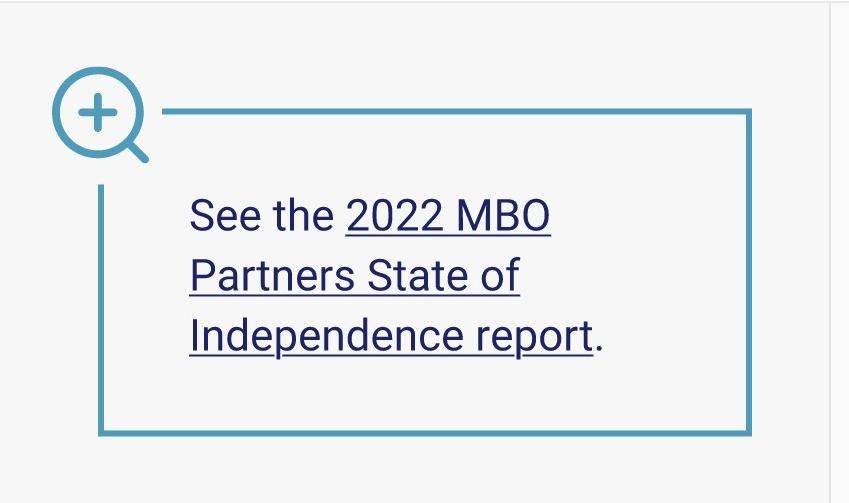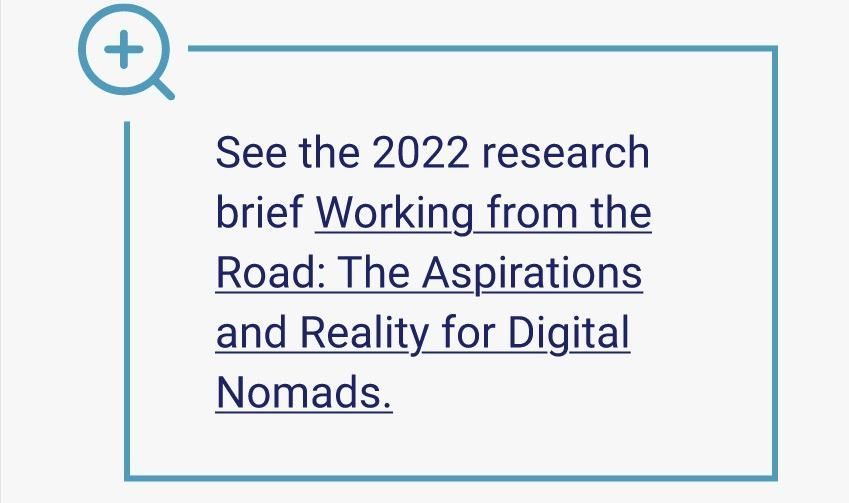Creator
Economy
Staking Out New Territory
Independent digital content creators are among the fastest-growing self-employment and independent work segments.
The 2022 MBO Partners State of Independence in America research study found that 8.1 million U.S. independent creators earned money in the creator economy in 2022, up a sizeable 14% compared to 2021.
The Number of Independent Creators
Increased 14% in 2022
(in millions)

They are a diverse group of full and part-time solopreneurs and micro-business owners who monetize their knowledge and skills by creating online digital content.
The 2022 MBO Partners State of Independence in America research study found that 8.1 million U.S. independent creators earned money in the creator economy in 2022, up a sizeable 14% compared to 2021.
The Number of Independent Creators Increased 14% in 2022
(in millions)

Defining Independent Creators
In this MBO State of Independence Research Brief, we explore the rise and growth of the creator economy and the attitudes, motivations, and demographics of independent creators who earn income from making and distributing online digital content.
While there is no standard definition of the creator economy or creators, we defined independent creators as independent workers (self-employed, solopreneurs, freelancers, etc.) who earn money by creating and distributing digital content.

Defining Independent Creators
In this MBO State of Independence Research Brief, we explore the rise and growth of the creator economy and the attitudes, motivations, and demographics of independent creators who earn income from making and distributing online digital content.
While there is no standard definition of the creator economy or creators, we defined independent creators as independent workers (self-employed, solopreneurs, freelancers, etc.) who earn money by creating and distributing digital content.
Meet the Independent Creators
Independent creators tend to be younger and skew male. About 7 in 10 (71%) are aged 40 or younger, and 57% are male.
Independent creators are also, on average, well educated. A bit over half (52%) report having a bachelor's degree (29%) or a bachelor's degree and higher (23%). This is substantially higher than the 38% who have a bachelor's degree or higher in the U.S. overall.
African Americans are more robustly represented in the creator economy (18%) compared with their U.S. population share overall (13%). Hispanic creators, however, are underrepresented (8%) compared to their population share (19%). White and Asian shares are similar to their percentages of the U.S. population.
Demographics of Independent Creators
Demographics of
Independent Creators



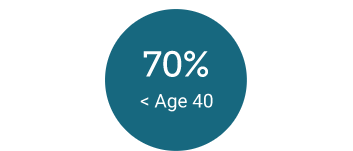

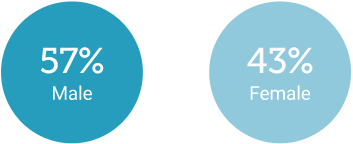
Many of the highest-paid content creators started as part-time amateurs and now have large online followings and earn millions of dollars. This combination of passion, potential fame and riches, and ease of entry makes part-time content creation attractive.

Most are Part-Time Independent Creators
Just over a third (36%)-or about 2.9 million-of income-earning digital content creators report working as creators full-time.
The majority (64%), or about 5.3 million income-earning digital content creators, report working part-time as content creators.
Percentage of Independent Creators
by Generation Type
Percentage of Independent Creators by Generation Type
Most content creators wear several income-earning hats and have multiple sources of income. Almost six out of ten (57%) independent creators also have traditional jobs, with 41% having full-time jobs and 16% having part-time jobs. And even most full-time independent creators (78%) say they have other sources of income beyond being a content creator.
Full-Time vs. Part-Time Independent Creators

36%
(2.9 million)
64%
(5.3 million)
Independent Creators: Entrepreneurial, Passionate, and Satisfied
Independent creators are entrepreneurial. Almost nine in ten (86%) report having always wanted to be their own boss. They're also highly satisfied with the path they've chosen.
Over 90% report being either highly satisfied (83%) or satisfied (9%) with their work as independent creators, and only 4% report being dissatisfied. Most independent creators are also passionate about their profession, with 68% saying that pursuing a passion is one of the reasons they became independent creators.
This passion shows in other data: 83% plan to continue as either an independent creator (57%) or build a bigger creator business (26%) over the next 2-3 years, 78% say doing something they like is more important than making the most money, and 79% report being optimistic about the future of their career.
Satisfaction as an Independent Creator

Highly satisfied

Satisfied

Disatisfied
Independent Creators Value their Flexibility and Lifestyle
Independent workers highly value the flexibility, autonomy, and control independent work provides.
Over eight in ten independent creators (84%) say they prefer a location-independent lifestyle that allows them to work and travel. About seven in ten say work/life flexibility is more important than making the most money. And two-thirds (68%) listed flexibility as a reason they became an independent creator.
So, it comes as no surprise that almost two-thirds (63%) report they are currently a digital nomad (39%) or have been one in the past (24%). It is the largest subsegment of independent digital nomads we track.
Most content creators also report being happier (87%) and healthier (81%) than if they had a traditional job, and 68% say they lead fulfilling lives.
Reflecting their satisfaction and happiness, 83% of independent creators recommend becoming independent content creators to their friends.
See the 2022 research brief Working from the Road: The Aspirations and Reality for Digital Nomads.
Independent Creators Value their Flexibility and Lifestyle
Independent workers highly value the flexibility, autonomy, and control independent work provides.
Over eight in ten independent creators (84%) say they prefer a location-independent lifestyle that allows them to work and travel. About seven in ten say work/life flexibility is more important than making the most money. And two-thirds (68%) listed flexibility as a reason they became an independent creator.
So, it comes as no surprise that almost two-thirds (63%) report they are currently a digital nomad (39%) or have been one in the past (24%). It is the largest subsegment of independent digital nomads we track.
Most content creators also report being happier (87%) and healthier (81%) than if they had a traditional job, and 68% say they lead fulfilling lives.
Reflecting their satisfaction and happiness, 83% of independent creators recommend becoming independent content creators to their friends.
Independent creators rely on digital tools and the internet in their work. Because of this, they report having strong technical skills.
Independent creators rely on digital tools and the internet in their work. Because of this, they report having strong technical skills.
Tech Savvy
Eighty-seven percent report being early adopters of technology, and 84% say they are advanced technology users. This compares to only 34% of traditional employees and 37% of independent workers as early technology adopters. Also, just 29% of traditional employees and 32% of independent workers say they are advanced technology users, per the State of Independence.
Ninety-seven percent of content creators say social media is very important (71%) or somewhat important (26%) for building their online reputation and brand. This compares to only 73% of independent workers saying social media is very important (35%) or important (38%) for building their online reputation and brand.
Online Platforms Used for Content Distribution
by Independent Creators
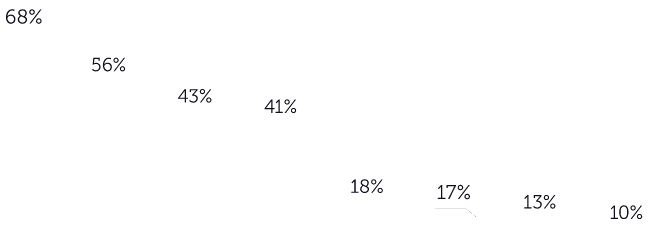
Online Platforms Used for Content Distribution
by Independent Creators
The Creator Economy is a Team Sport
Independent creators are more likely to partner with other independent creators and freelancers than independent workers.
About half of all independent creators (48%) report teaming up with other content creators on projects, compared to only 23% of independent workers who aren't content creators. Looking forward, 68% of content
creators plan to partner with other independent workers over the next year, while only 29% of independent workers plan to do so.
Also, 34% of independent creators have hired other freelance contractors to help with their business, while only 14% of independent workers have done so.

The Challenges Independent Creators Face
Independent creators face most of the same struggles as all independent workers, so it's not surprising that they report the same overall challenges. These include:
-
Lack of predictable income
(43% of independent workers and 48% of content creators)
-
Creating a pipeline/marketing
(31% of independent workers and 37% of content creators)
-
Lack of benefits
(26% of independent workers and 28% of content creators)
Two challenges are more daunting for content creators than other independent workers: achieving success and avoiding burnout.
Almost four in ten independent creators (39%) say it's hard to be successful compared to only about one in five (21%) independent workers. And, setting work/life boundaries when income streams depend on engaging followers is challenging.
Because of this, over one-third of all content creators (38%) report struggling with boundaries and burnout versus only 21% of independent workers.
The burnout and mental health issues associated with the creator economy have been widely documented in the press. Clearly, the stress and pressure of constantly producing engaging content and the time required to run their businesses results in even highly successful creators experiencing burnout and other mental health issues.
Income in the Creator Economy
Creators like Mr. Beast, the D'Amelio sisters and others have vast online followings and huge earnings.
Our survey findings back this up, with about 73,000 independent creators-almost 1% of independent creators-report annual income over $1 million.
It is important to note-like other independent workers-even most full-time independent creators report that content creation is not their only source of income. On average, those saying they are full-time content creators report that about 68% of their revenue comes from digital content creation, with 32% coming from other sources.
Independent Creator Earnings
(Share of Earnings by Dollar Categories - 2022)
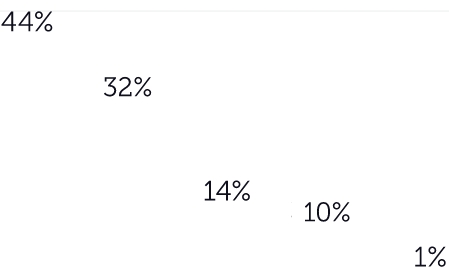
Income in the Creator Economy
Creators like Mr. Beast, the D'Amelio sisters and others have vast online followings and huge earnings.
Our survey findings back this up, with about 73,000 independent creators-almost 1% of independent creators-report annual income over $1 million.
It is important to note-like other independent workers-even most full-time independent creators report that content creation is not their only source of income. On average, those saying they are full-time content creators report that about 68% of their revenue comes from digital content creation, with 32% coming from other sources.
Independent Creator Earnings
(Share of Earnings by Dollar Categories - 2022)
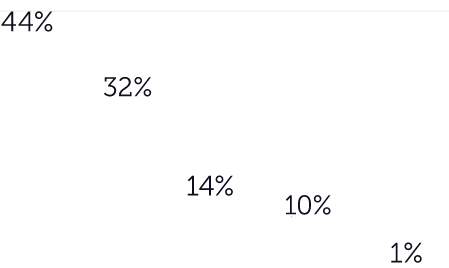

We asked Americans aged 18 and over who aren't independent creators, or creators with traditional jobs, if they plan to become independent creators over the next two years. Some 3.6 million said yes, while 7.4 million said maybe.
We asked Americans aged 18 and over who aren't independent creators, or creators with traditional jobs, if they plan to become independent creators over the next two years. Some 3.6 million said yes, while 7.4 million said maybe.
Many Aspire to be Independent Creators
The creator economy has generated enormous buzz and media attention over the past several years.
Our study cites that 8.1 million Americans earned money as an independent creator in 2022. But an additional 4.9 million Americans said they participated in the creator economy as independent creators but did not earn income from their creator economy activities. Over half (51%) of this group said they plan to make money from their creator economy activities over the next year.
We also asked creators with traditional jobs about their future career plans. A stunning 41% said they definitely (15%) or probably (26%) will become an independent worker or start a business over the next 24 months. Overall, only 16% of traditional job holders report they definitely (7%) or probably (9%) will become independent or start a business over the next 24 months.
Despite their aspirations, our research indicates that only about 9% and 13% of those saying they will become independent creators will follow through and join the ranks of the creator economy.
Number of Participating Independent Creators Who Earned Income
The Trends Driving Future Creator Economy Growth
A powerful set of trends and shifts will continue to drive growth in the creator economy. First, the creator economy is part of a broader shift to independent work. The COVID-19 pandemic accelerated this shift, and the number of independent workers substantially increased in 2021 and 2022.
The pandemic also resulted in Americans rethinking work and the role it plays in their lives. Becoming an independent creator allows workers to pursue their creative passions and have the work/life flexibility and control many seek. Technology is making creative endeavors cheaper and easier. Internet platforms like YouTube, TikTok, Instagram, and others provide independent creators access to vast audiences. Relatively
inexpensive yet powerful content creation software and hardware has democratized content creation, allowing even solopreneur independent creators to produce content that matches the quality of Hollywood.
Most independent creators come from the two youngest generational cohorts. Their numbers will likely increase as more Gen Zers enter the workforce, and younger creatives gain the skills, experience, and confidence to become self-employed. There's also a burgeoning number of firms providing resources and services for independent creators. This growing support system helps independent creators run their businesses, generate revenue, produce professional content, and find and engage audiences.
